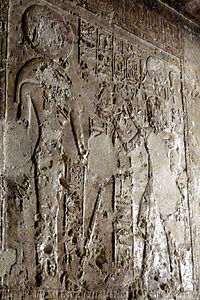Pachet
| Pachet in hieroglyphics | |||||
|---|---|---|---|---|---|
Pachet P3ḫt The scratching / the tearing |
|||||
Pachet P3ḫt |
|||||
| Pachet in the Speos Artemidos | |||||
Pachet or Pechet is an ancient Egyptian goddess from the area of Beni Hassan . Her name means "The Scratching One" or "Tearing One", which indicates her importance as a warlike goddess.
iconography
There are very few depictions of this goddess in ancient Egyptian art . She usually has the shape of a lion, but also appears as a woman with a lion's head who wears a disk of the sun on her head. Depictions in Hibis show Pachet as a seated baboon. No special divine attributes are assigned to it.
mythology
It is known from coffin texts of the Middle Kingdom by Beni Hassan. Günther Roeder calls her a "goddess with sharp eyes and pointed claws who gets food at night". Pachet was said to instill horror in her enemies. The goddess is one of the lion deities and is naturally aggressive.
Pachet has various nicknames. So she was called “goddess at the entrance of the wadi”, but she was also “mistress of the desert that dwells in the middle of the eastern desert” and is also called “ruler of the two countries” ( Upper and Lower Egypt ) as well as “mistress of heaven “Titled.
She was equated with the goddesses Weret Hekau , Sachmet and Isis . As the lion goddess she is also one of those deities who participate in the "eye saga".
Cult and places of worship
The cult of Pachet was not limited locally. Their main area of influence and cult was the area of Beni Hasan in Middle Egypt . Here is her temple sanctuary, a rock temple that was laid out by Queen Hatshepsut and by Thutmose III. as well as Seti I was then further expanded. The Ptolemies later called the sanctuary Speos Artemidos ("Grotto of Artemis") because they equated Pachet with their Greek goddess Artemis . For their cult, extensive cat cemeteries were built near the temple in the late period.
See also
literature
- Hans Bonnet : Lexicon of the Egyptian religious history. Nikol, Hamburg 2000, ISBN 3-937872-08-6 , p. 578.
- Richard H. Wilkinson : The world of the gods in ancient Egypt. Belief, power, mythology. Theiss, Stuttgart 2003, ISBN 3-8062-1819-6 , p. 180.

